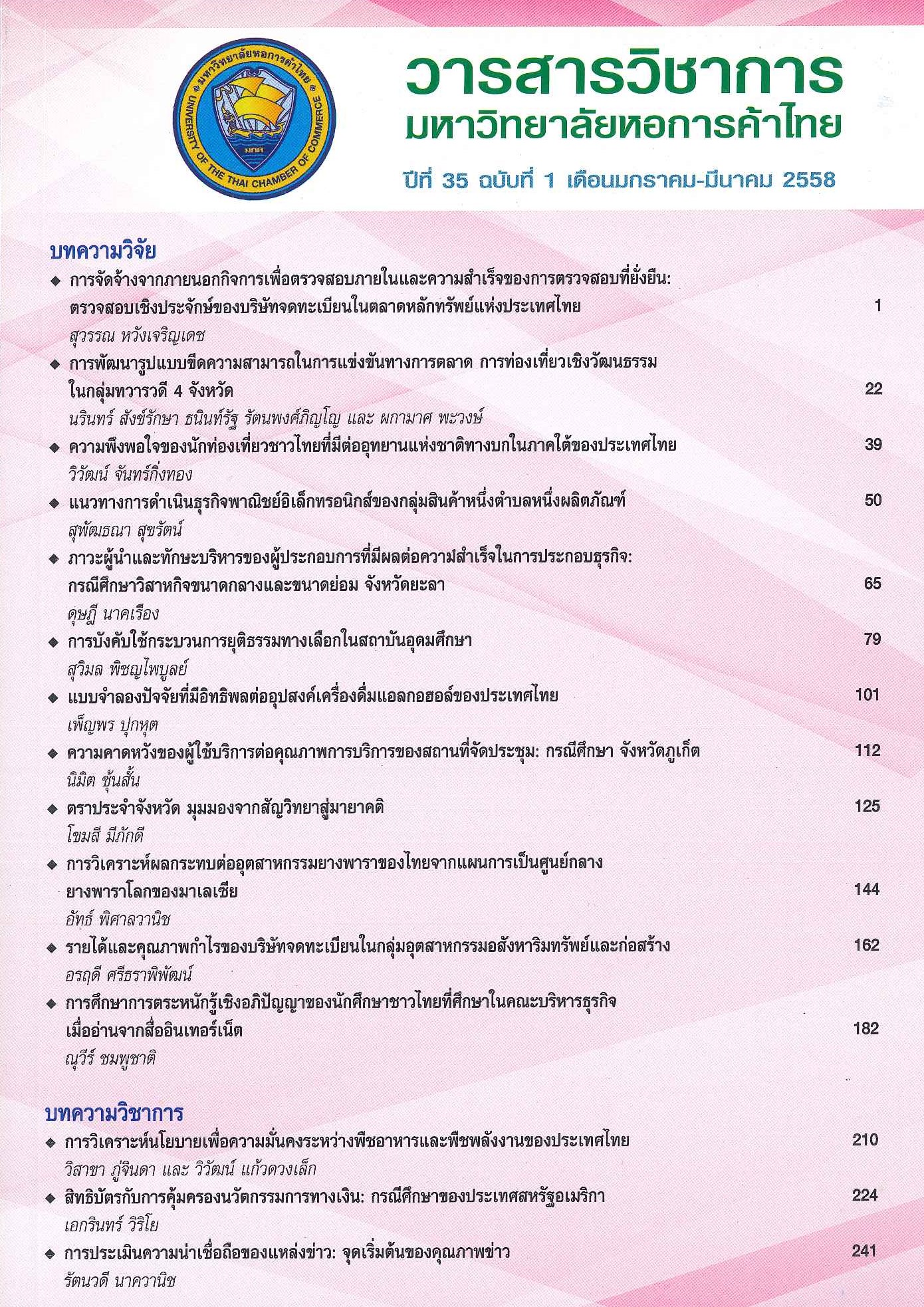The Analysis of the Effects of the Malaysian Plan to Become the World's Rubber Center on Thai Rubber lndustry
Main Article Content
Abstract
This research project aimed to analyze the effects of the Malaysian plan to become the world's rubber center on the Thai rubber industry, In addition, it studies the supply-chain of the rubber industry in Thailand and Malaysia. Simultaneous Equation Models were applied and in-depth interviews with both Thai and Malaysian entrepreneurs. The results showed that Malaysia has tried to promote the rubber industry to play a more important role in its economy. The rubber industry has been set to be one of the 12 national key economic areas (NKEAs) so that Malaysia would become a high-income country. Moreover, Malaysia aims to be the world's rubber center by 2020 with the purpose of increasing domestic products and decreasing imports. Value added through the rubber products is also emphasized by focusing on the importance of producing downstream products, especially rubber gloves. They are set to gain 65 percent of the market share in the world market. At present, Malaysia has a better supply-chain in the rubber industry than Thailand. Malaysia continuously produces concentrated latex rubber and uses it as raw materials in upstream and downstream products. However, it cannot produce enough concentrated latex rubber so that it needs to import, especially from Thailand. Therefore, if Malaysia becomes the world's rubber center, the demand for Thai rubber from Malaysia will decrease. Moreover, Thailand may lose its market share in rubber product exports, especially in the export of rubber gloves.
Article Details

This work is licensed under a Creative Commons Attribution-NonCommercial-NoDerivatives 4.0 International License.
ลิขสิทธิ์ของบทความ
ผลงานที่ได้รับการตีพิมพ์ถือเป็นลิขสิทธิ์ของมหาวิทยาลัยหอการค้าไทย ห้ามมิให้นำเนื้อหา ทัศนะ หรือข้อคิดเห็นใด ๆ ของผลงานไปทำซ้ำ ดัดแปลง หรือเผยแพร่ ไม่ว่าทั้งหมดหรือบางส่วนโดยไม่ได้รับอนุญาตเป็นลายลักษณ์อักษรจากมหาวิทยาลัยหอการค้าไทยก่อน
References
Burger, Kees, and Smit, Hidde P. 2000. Natural Rubber in the Coming Decade: Policies and Projection. Singapore: International Rubber Study Group.
Ciullo, Peter A., and Hewitt, Norman. 1999. The Rubber Formulary. Norwich, NY: Noyes Publications.
Escaith, Hubert, and Inomata, Satoshi, eds. 2011. Trade Patterns and Global Value Chains in East Asia: From Trade in
Goods to Trade in Tasks. n.p.: World Trade Organization and IDE-JETRO.
FPT Securities Joint Stock Company. 2013. Natural Rubber Industry Report 2013. Hanoi: FPT Securities Joint Stock Company.
Global Trade Atlas. 2013, May 15. Data Statistics [Online]. Available: https://www.gtis.com/gta/
kiyota, Kozo, Sazan ami, Yoko, and Wong, YuChing. 2012, September 25. Intra-Regional Trade in Asia: Dynamics of
Production Sharing [Online]. Available: https://www.univ-lehavre.fr/actu/itlcsge/kiyota_2.pdf
Malaysia. Department of Statistics. Annual Rubber Statistics 2010. Putrajaya: Department of Statistics.
Malaysian Investment Development Authority. 2012. Malaysia Investment Performance 2011. Kuala Lumpur: Malaysian Investment Development Authority.
Malaysian Rubber Board. 2011. Natural Rubber Statistics 2011. Kuala Lumpur: Malaysian Rubber Board.
Malaysian Rubber Board. 2012a. Malaysian Rubber Exchange Membership Directory 2010. Kuala Lumpur: Malaysian Rubber Board.
Malaysian Rubber Board. 2012b. Malaysian Rubber Industry and Products Directory 2010-2011. Kuala Lumpur: Malaysian Rubber Board.
Malaysian Rubber Board. 2012c. Natural Rubber Statistics 2012. Kuala Lumpur: Malaysian Rubber Board.
Malaysian Rubber Board. 2013. Malaysian Rubber Exchange Directory 2012. Kuala Lumpur: Malaysian Rubber Board.
Mohd Hafizzuddin Md Damiri. 2013. Natural Rubber Statistics 2012. Kuala Lumpur: Rubber Market Study Unit, Economics and Rubber Exchange Division, Malaysian Rubber Board.
Mohd Hafizzuddin Md Damiri. n.d. Trade and Transport Facilitation: The Malaysian Experience and Milestones. Kuala
Lumpur: Services Development Division, Ministry of International Trade and Industry.
Moir, G.F.J., ed. 2012. "Production, Consumption, Market." Malaysian Rubber Review 15: 1-34.
Muhamad Thalhad Ab Karim. 2010. "Sustainability of Rubber Industry in Malaysia: Economic and Social Perspective." in IRRDB-CATAS International Rubber Conference, 18-19 October 2010, Hainan, PRC, pp. 14-28. n.p.
Pisanwanich, Aat. 2012. Rubber and Rubber Productions [Online]. Available: https:// www.statistics.gov.my/portal/index.php?lang=en
Pisanwanich, Aat. 2013. "The Study of te Potential of Thai Industrial Goods under BIMSTEC Agreement." University of Thai Chamber of Commerce Journal 33, 2: 125-148. (in Thai).
อัทธ์ พิศาลวานิช. 2556. "การศึกษาศักยภาพสินค้าอุตสาหกรรมของไทยภายใต้กรอบความร่วมมื่อ BIMSTEC."วารสารวิชาการ
มหาวิทยาลัยหอการค้าไทย 33, 2: 125-148.
Smit, Hidde. 2011. Rubber Price Trends: The Shape of Things to Come, India Rubber. n.p.
Sumormo, Suarni. 2012. "Economic Transformation Programme: Shaping Malaysian Rubber Industry for 2020." in International Rubber Technology and Economic Congress, 10-11 October 2012, One World Hotel, Pettaling Jaya,
Selangor, Malaysia. n.p.


